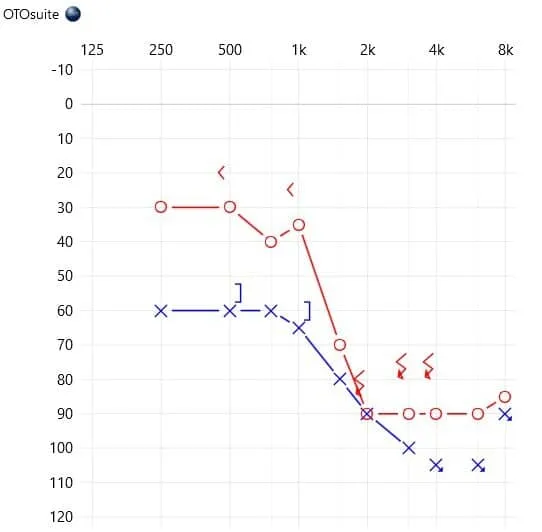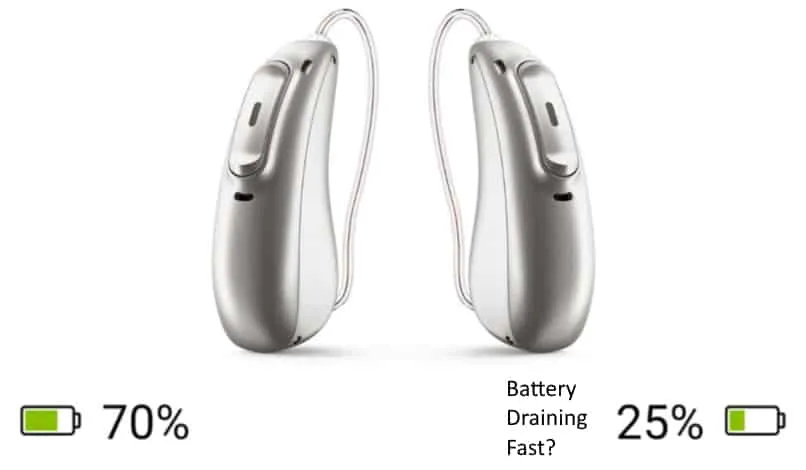Hearing aids have revolutionized the lives of individuals with hearing loss, allowing them to reconnect with the sounds and conversations around them. These incredible devices rely on batteries to function, but have you ever wondered why one hearing aid battery dies before the other? In this article, we will explore the most common reasons behind this phenomenon, shedding light on the factors that affect battery life in hearing aids.
| Reason | Explanation |
|---|---|
| Varying degrees of hearing loss | The greater the degree of hearing loss, the more power the hearing aid requires, leading to faster battery drain in the aid fitted to the more affected ear. |
| Bluetooth connectivity and cell phone usage | The hearing aid connected to a cell phone via Bluetooth consumes additional battery power, often resulting in faster battery depletion. |
| Inadequate battery capacity | Aging hearing aid batteries lose their charge-holding capacity, causing them to drain faster. Replacing the battery ensures consistent performance. |
| Battery lifespan of rechargeable batteries | Rechargeable batteries have a limited lifespan of approximately 3-4 years. As they age, their capacity diminishes, resulting in shorter battery life. |
| Earwax accumulation and feedback | Earwax obstruction can cause sound waves to bounce back into the hearing aid, leading to increased feedback cancellation system usage and higher power drain. |
| Environmental factors | Different environments, such as outdoor activities or occupational settings, can subject one hearing aid to varying levels of humidity, dust, or temperature. |
| Manufacturer repair and battery replacement | If one hearing aid has been repaired by the manufacturer, it may have a newer battery, resulting in a potential imbalance in battery life between the aids. |
Varying Degrees of Hearing Loss

One significant factor that can cause one hearing aid battery to die before the other is the presence of different levels of hearing loss in each ear. The greater the degree of hearing loss, the more power the hearing aid requires to amplify and process sound. Therefore, the hearing aid fitted to the ear with more severe hearing loss will consume more energy, leading to a faster battery drain.
Learn more about the audiogram.
Bluetooth Connectivity and Cell Phone Usage
In many cases, (especially for Phonak products) the right hearing aid is the one that connects via Bluetooth to a cell phone or other audio devices. This wireless connectivity allows users to stream phone calls, music, and other audio directly into their hearing aids. While this feature enhances convenience and accessibility, it also consumes additional battery power. As a result, the right hearing aid, responsible for the Bluetooth connection, often dies before the left hearing aid.
Inadequate Battery Capacity
If a hearing aid does not last the entire day on a single battery charge, it may be an indication that the battery itself needs to be replaced. Over time, hearing aid batteries lose their capacity to hold a charge efficiently. As a result, they may drain faster, leaving one hearing aid without power before the other. Replacing the battery in a timely manner ensures consistent performance and avoids disruptions in hearing aid usage.
If your hearing aid is ever sent in for repair, the company likely replaced the battery, and that hearing aid will last longer.
Battery Lifespan of Rechargeable Batteries
Rechargeable batteries have gained popularity due to their convenience and environmental benefits. However, it’s important to note that even rechargeable batteries have a limited lifespan. On average, rechargeable batteries used in hearing aids should be replaced every 3-4 years, depending on usage patterns. As these batteries age, their capacity diminishes, leading to shorter usage time and a potential imbalance in battery life between the hearing aids.
Manufacturer Repair and Battery Replacement
In some cases, when a hearing aid undergoes repair or servicing by the manufacturer, it is common for them to replace the battery as part of the maintenance process. This means that the hearing aid that has been serviced will have a newer battery compared to its partner aid.
The replacement of the battery during repair can introduce a disparity in battery life between the two hearing aids. The newer battery in the serviced hearing aid may have a higher capacity and perform more efficiently, resulting in a longer battery life compared to the hearing aid with the original battery.
If you have sent one of your hearing aids for repair, it’s essential to be aware of this potential discrepancy in battery performance. Monitor the battery life of both hearing aids closely to ensure that the hearing aid with the older battery is not left without power before the other. If needed, consider replacing the battery in the other hearing aid to maintain balance and consistent performance.
It’s advisable to consult with your audiologist or the manufacturer’s customer service for guidance on battery replacement and to discuss any concerns regarding battery life imbalance caused by manufacturer repair or servicing.
Additional Possible Reasons
Earwax Accumulation
Earwax, also known as cerumen, can create an obstruction in the ear canal, affecting the performance of the hearing aid. When earwax builds up, it can cause sound waves to bounce out of the ear and re-enter the hearing aid microphones. This results in a phenomenon called hearing aid feedback, where the amplified sound is reintroduced into the system.
The feedback cancellation system in the hearing aid works harder to suppress this feedback, leading to an increased power drain. Consequently, one hearing aid may experience a faster battery drain compared to the other if it is affected by earwax accumulation and subsequent feedback. Regular cleaning and maintenance of the ear can help minimize this issue and ensure optimal battery performance.
Environmental Factors
The environment in which hearing aids are used can impact battery life. High levels of humidity, temperature extremes, exposure to moisture or sweat, and other environmental factors can affect the performance of the hearing aid and its battery. If one hearing aid is consistently exposed to more challenging environmental conditions than the other, its battery may drain faster due to increased power demands.
Conclusion
Understanding why one hearing aid battery dies before the other can help hearing aid users manage their devices more effectively. Factors such as varying degrees of hearing loss, Bluetooth connectivity and cell phone usage, inadequate battery capacity, battery lifespan, earwax accumulation, and environmental factors all play a role in determining battery life discrepancies. If you notice significant differences in battery life between your hearing aids, consult with your audiologist to ensure optimal performance and consider replacing batteries when necessary. Remember, maintaining consistent battery power is crucial for uninterrupted hearing aid usage and improved quality of life.

